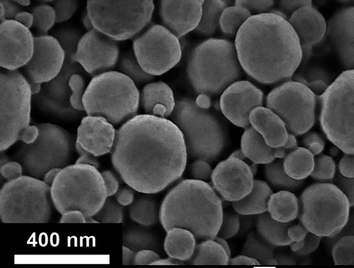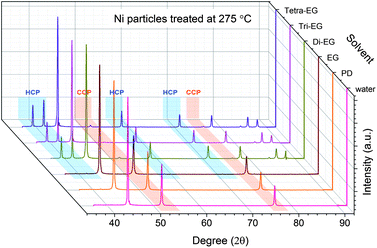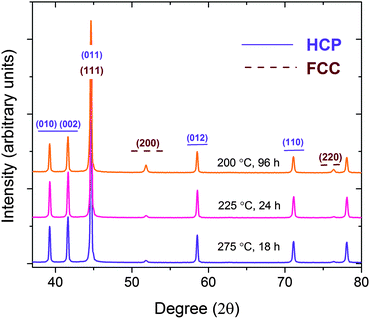Mechanism of polyol assisted ccp to hcp crystal phase conversion of nickel particles
Igor V. Sevonkaev,
Ajeet Kumar,
Angshuman Pal and
Dan V. Goia*
Center for Advanced Materials Processing, Department of Chemistry and Biomolecular Science, Clarkson University, Potsdam, NY 13699, USA. E-mail: goiadanv@clarkson.edu; Tel: +1 315 268 4411
First published on 26th November 2013
Abstract
The effect of different chain length glycols on the conversion of ferromagnetic ccp nickel nanoparticles to antiferromagnetic hcp structure was investigated. To be an effective crystal phase tuner, the glycol molecule must have both an ether fragment and a linear chain structure. The phase conversion was studied at reaction times up to 100 hours and temperatures between 200 and 275 °C. Under selected conditions nickel particles of pure or mixed crystal structure could be generated.
Introduction
Ferromagnetic metals such as nickel, cobalt, and iron are widely used in a broad range of applications.1–9 Nickel, in particular, has been the focus of extensive research due to its use in magnetic storage devices,10–12 biomedicine,13–16 multifunctional magnetic rotators,17 opto- and ferro-fluids,4,18–21 electro-chemical organic catalysis,22–26 and batteries.27,28Under normal conditions, nickel has a ccp structure (also known as a face-centered cubic or fcc) and exhibits ferromagnetic properties.29 At temperatures in the 200–360 °C range, however, it can be converted to an antiferromagnetic hcp form.30–32 This has brought attention to the synthesis and characterization of hcp Ni particles because of their unique properties emanating from size, crystal structure, and mutual interactions.29,30,33–35
To date, Ni particles with various sizes and shapes have been prepared by chemical reduction, sputtering,36 thermal processes,32,37,38 reverse microemulsion technique,39 and polyol mediated processes.30,40–42 These methods typically yield Ni particles with either an hcp or a ccp crystal structure. In this paper we propose a versatile approach for controlling the conversion of ccp nickel to hcp, allowing the preparation of particles with a single crystal phase or a controlled degree of conversion from one phase to the other. The method at the core of this study was originally proposed by Kim et al.43 While their work receives the merit for discovering the phenomenon, it did not elucidate the underlying mechanisms. The objective of this study was to fill this void and identify conditions for controlling the phase conversion by varying key process parameters. The approach described is simple, cost effective, creates only a mild environmental impact, and is capable of generating dispersed hcp particles at high metal concentrations.
Experimental
Materials and methods
The spherical nickel particles were received from Kawatetsu/Japan. They are essentially monocrystalline entities prepared using a chemical vapor deposition (CVD) process, having an average size of ∼160 nm (Fig. 1).Water, glycerol (GL), 1,2-propane diol (PD), ethylene glycol (EG), di-ethylene glycol (Di-EG), tri-ethylene glycol (Tri-EG), and tetra-ethylene glycol (Tetra-EG) were the dispersion media selected for crystal phase conversion. The molecules of ethylene glycol, di-ethylene glycol, tri-ethylene glycol, and tetra-ethylene glycol can be schematically represented by the following general formula
| H(OCH2CH2)EFOH | (1) |
All polyols were obtained from Fluka and were used without further purification. The size and shape of nickel particles were determined by transmission (TEM JEM-2010) and field emission scanning (FESEM JEOL-7400) electron microscopy. Their crystal structure was assessed by X-ray powder diffraction (XRD) using a Bruker-AXS D8 Focus X-ray diffractometer. The scanning step width was 0.01 degree, the step period 4 s, while the source, sample, and detector slits were 2, 0.6, and 1 mm, respectively.
Closed system setup
For each solvent, 0.5 g of Ni powder were introduced into a 100 ml high-pressure vessel containing 40 ml of solvent (Table 1). After an 18 hour incubation in the sealed reactor at 275 °C, the nickel particles were separated, washed, dried, and analyzed. This setup was necessary in order to maintain all solvents, for an extended time, at a temperature high enough (275 °C) to allow a measurable rate of phase conversion.Open system setup
Ten grams of nickel powder were dispersed in 400 ml of Di-EG in a 500 ml round-bottom reactor. The reactor was placed in a heating mantle and the temperature was brought to either 200 °C or 225 °C. The nickel dispersions were maintained at the set temperature for up to 96 h under continuous stirring. Samples were extracted from the reactor at different times for XRD analysis.Results and discussions
Metallic nickel can exist in either ccp (JCP-004-0850) or hcp (JCP-045-1027) crystal phases. The latter forms only within a specific temperature range (200–325 °C).31 Once hcp-Ni is formed, it is stable at temperatures below 325 °C but reverts back to ccp when the temperature is increased above 360 °C.30–32Considering the metastable nature of the hcp phase, it is difficult to obtain by fast growth techniques (i.e. CVD, spray pyrolysis) Ni particles having a well-defined and controllable ccp/hcp ratio. However, it was previously shown that this can be achieved via slow phase transition taking place when Ni particles are kept for extended times in solvents that have sufficiently high boiling points. Polyols have been the preferred dispersion media for such studies.31 In their work, Tzitzios et al.35 suggested that polyols with a higher molecular weight have elevated boiling points and are more effective in converting the Ni to an hcp structure. In this view, the temperature appears to be the only important process parameter. Our preliminary investigations however, revealed that the structure of the polyol molecule may be an even more critical factor in the conversion of Ni from the ccp to the hcp phase. The results of subsequent investigations presented here confirm this alternate view.
To separate the effects of temperature and molecular structure of the glycols, we first heated for extended intervals the dispersions of ccp Ni particles in solvents with a very broad range of boiling points. The treatment temperature (275 °C) was selected due to its median in the temperature range that favors the phase conversion.27 In order to maintain the low boiling solvents at the set temperature, a closed system was used. When ccp Ni particles were kept for 18 h in the solvents listed in Table 1, the degree of conversion to hcp phase did not follow the expected trend based on their boiling points. As indicated by the XRD analysis (Fig. 2 and Table 2), after incubation in either water or PG the structure of the Ni particles remained essentially unaffected.
| Peak intensity, a.u. | ||||||||
|---|---|---|---|---|---|---|---|---|
| Phase | 2θ | hkl | Water | PD | EG | Di-EG | Tri-EG | Tetra-EG |
| hcp | 39.28 | 010 | n/a | n/a | 30 | 716 | 917 | 1012 |
| 41.63 | 002 | n/a | n/a | 40 | 916 | 1171 | 1279 | |
| ccp | 51.82 | 200 | 2290 | 2515 | 2557 | 1005 | n/a | 100 |
| hcp | 58.56 | 012 | n/a | n/a | n/a | 513 | 664 | 750 |
| 71.18 | 110 | n/a | n/a | n/a | 480 | 608 | 684 | |
| ccp | 76.32 | 220 | 1219 | 1285 | 1290 | 532 | n/a | 70 |
| hcp | 78.10 | 103 | n/a | n/a | 10 | 494 | 621 | 660 |
The Rietveld refinement applied to the {2 0 0} crystallographic planes clearly indicated that the hcp-Ni crystal phase was not present. This means that the thermal re-arrangement of metal atoms did not occur for these two solvents.
For the sample kept in ethylene glycol (EG) only the structure and morphology of the outer particles' surface changed. The native thin layer of NiO (Fig. 3a), estimated by high resolution TEM to have a thickness of 7 ± 3 nm and representing ∼15% of the particle weight, was reduced by the solvent, forming a “pyramidal” hcp-Ni surface (Fig. 3b). Indeed, Rietveld refinement of the XRD data revealed that ∼7–10% of hcp-Ni is present in the final powder. This suggests that the EG molecules reduced the nickel oxide to metallic nickel, which crystallized in an hcp-structure. The conversion did not, however, affect the core of the particles, which preserved the ccp structure.
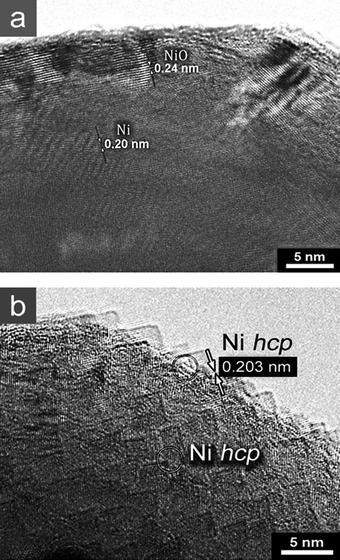 | ||
| Fig. 3 (a) TEM surface analysis of ccp-Ni particles reveals a thin (5–10 nm) NiO layer; (b) the superficial metal-oxide layer was converted into pyramidal hcp-Ni layer. | ||
In contrast, Ni powders kept in glycols with EF = 2, 3 and 4 underwent significant crystallographic and morphological changes. The XRD indicated that the entire body of the particles gradually re-crystallized in the hcp system. The characteristic peaks for the ccp system at 2θ (51.8° and 76.3°) have completely disappeared while those representative of the hcp phase (39.3°, 41.6°, 58.6°, and 71.2°) emerged (Fig. 2 and Table 2). As can be seen from XRD in Fig. 2, a small amount of ccp-Ni remained in the resulting powders. This may indicate that for a few very large Ni particles the phase conversion process did not reach their inner cores. The electron microscopy data revealed that the re-crystallized Ni particles had an entirely new morphology, changing in form from spherical to polygonal (Fig. 4).
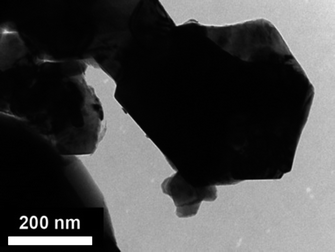 | ||
| Fig. 4 TEM image of a typical hcp Ni particles formed after 18 h at 275 °C after incubation in glycols with EF ≥ 2 (eqn (1)). | ||
Both XRD data and TEM analysis (Fig. 2–4), indicated that the hcp Ni particles obtained for all three polyols are highly crystalline. The calculated crystallite size determined by applying the Scherrer's equation to the (0 0 2) plane (Fig. 5) is comparable with the particle size observed by electron microscopy (Fig. 4). In the case of EG, however, the value is much smaller (∼7 nm) as the conversion to hcp structure was confined to a thin surface layer (Fig. 3b).
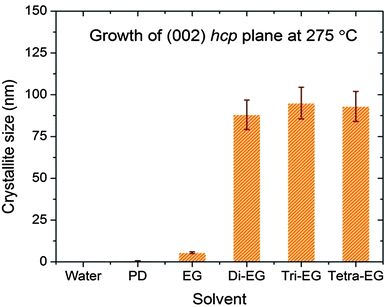 | ||
| Fig. 5 Calculated crystallite sizes corresponding to the (0 0 2) crystallographic plane of the formed hcp-Ni phase. | ||
Effect of time and temperature on Ni phase conversion
As indicated by the data above, any linear poly-glycol containing an ether fragment (–O–) may be used for Ni crystal phase conversion. Although solvents with a longer molecule chain appear to be more effective (i.e. shorter conversion times), Di-EG was selected as a dispersion medium for the open system for several reasons. First, since it has a high boiling point (245 °C), it provides an opportunity to work in an open vessel system. Second, Di-EG has the lowest viscosity of all glycols at ambient temperature44 allowing easier separation of Ni particles. The evolution of the Ni particles crystal structure in Di-EG at 200 °C was monitored for 96 hours and evaluated by XRD (Fig. 6). As shown by the diffractograms in Fig. 6, there was no detectable structural change for the first 10 h. The characteristic peaks for the hcp phase start to emerge in the XRD patterns after ∼18 h and continue to increase gradually in intensity for the next 78 h.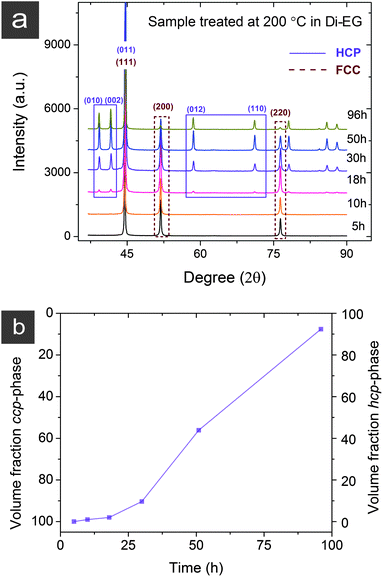 | ||
| Fig. 6 (a) Evolution of ccp to hcp-Ni particles crystal phase at 200 °C; and (b) ccp to hcp conversion rate. | ||
The ratio of the (2 0 0) peak of the ccp phase (i.e., near 2θ = 51.83°) and the (0 0 2) reflection of the hcp phase was used to estimate the rate of ccp-to-hcp conversion (Fig. 6b). Based on this plot, conditions needed for a desired ratio of the two phases can be easily identified. When Ni particles were kept in Di-EG at 225 °C, it took only 24 h to convert a larger fraction of the Ni ccp into the hcp phase (Fig. 7).
Mechanism of nickel conversion from ccp to hcp
Based on the data presented, we propose the following mechanism for Ni crystal phase conversion in polyols. The essential element of the new view is: in order to be both a reducing agent and an efficient crystal phase tuner, the glycol molecule must contain an ether fragment. It is known that the hydroxyl groups of any polyol efficiently bind to the metal oxide surface45 and reduce it to metallic nickel by lowering the surface activation energy of the redox reaction.35 Indeed, a polyol without an ether group (propane diol) reduces the nickel oxide layer but the resulting metal atoms adopt the same ccp structure as the particle core, which acts as a template for their spatial arrangement. As a result, the XRD pattern contains only peaks characteristic for the ccp phase. On the other hand, glycols that possess at least one ether group, manage to not only reduce the NiO superficial layer, but also re-arrange the atoms of both, surface and particle core from a ccp to an hcp configuration. The likely mechanism of this phase transformation is through 'dislodging' and transport of Ni atoms from locations in the ccp crystal to new locations where the atoms adopt the hcp arrangement. This may occur by either a surface diffusion46 or ‘dissolution–reprecipitation’ mechanism. The rearrangement of the atoms is presented schematically in Fig. 8, which is inline with TEM data in Fig. 3b.In both cases it is evident that the –O– groups play an essential role in ensuring the transport and rearrangement of Ni atoms. It also appears that an increased number of –O– fragments in the molecule increases the efficiency of the Ni atom transport from the ccp to the hcp locations. This is clearly confirmed by the trend in the intensity of the hcp reflections in Table 2.
Ethylene glycol presents an interesting case, where the conversion is restricted to the superficial layer of atoms resulting from the reduction of Ni2+ ions from NiO. Although, as PD, ethylene glycol molecules do not contain an ether fragment, they can react in the conditions of the experiment (high temperature and the presence of a metal surface with catalytic properties) to form dimers that do possess the –O– group capable of facilitating the rearrangement of superficial Ni atoms. The process is slow, however, since the concentration of the –O– containing dimers formed is much lower than the concentration of in the three polyols already containing this moiety in their molecule. In the case of PD, which has only one terminal carbon containing an OH group, the probability of collisions that lead to water elimination and the formation of –O– fragments is drastically reduced. In the absence of a significant number of –O– containing groups, the atoms resulting from the reduction of the NiO layer are deposited in the same ccp arrangement as the subsurface core template. A further confirmation of the essential role of the intra-molecular ether groups in the phase conversion was provided by experiments carried out in glycerol. This polyol has a very high boiling point (290 °C) and, according to the previous view that only a high temperature is needed, should be a very effective phase conversion promoter. Our investigations however, revealed that with incubation in the open system under the same conditions of temperature (225 °C) and time (24 h) as for Di-EG, conversion from ccp to hcp is negligible (Fig. 9, orange plot). Even at a higher temperature (250 °C), the conversion of Ni atoms from the NiO layer to hcp structure (Fig. 9, violet plot) can hardly be observed. This suggests that the etherification process at these temperatures is negligible. This behaviour can most likely be attributed to the following factors: the incubation was carried out at a much lower temperature than the boiling point of glycerol and an –OH group was present between the terminal hydroxyl groups.
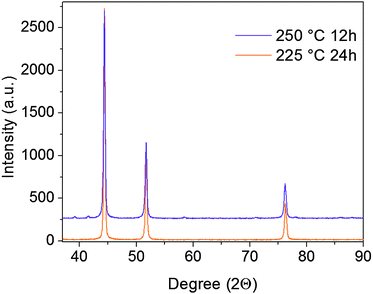 | ||
| Fig. 9 XRD pattern of Ni particles maintained in glycerol at 250 °C for 12 hours (top) and 225 °C for 24 hours (bottom). | ||
Conclusions
This study presents a simple and convenient method for changing the structure of crystalline nickel particles from ccp to hcp in a controllable manner. The conversion of Ni lattice was investigated at high temperature in various polyols. In contrast with the findings of previous studies, we have shown that the structure of glycol molecules, and not the temperature at which the conversion is carried out, is the most critical factor in the re-crystallization of Ni. For this purpose, polyols with different structure and boiling points were used as solvents for phase conversion. We have shown that, in order to be effective as a phase changer, the polyol molecule must be linear and contain at least one ether fragment. The –O– moiety is responsible for the mobility of Ni atoms in the ccp lattice and their transport and re-arrangement into distinct crystalline entities having an hcp structure. Effectiveness of the phase conversion increases with the number of –O– fragments in the polyol molecule. Polyols not containing an ether fragment are largely ineffective as phase tuners. Exceptions are the linear polyols with two terminal hydroxyl groups, which during the high temperature process can dimerize and form in situ –O– groups. However, given the low concentration of these species, the conversion process is confined to the surface of the particles.Acknowledgements
Authors are grateful for financial support from Umicore AG (Hanau/Germany). We also acknowledge the valuable discussions with Prof. Vladimir Privman (Clarkson University), Dr Alexandr Trotsenko, and Brandon Bartling of GE Global Research (Niskayuna, NY).Notes and references
- S. Sun and C. B. Murray, J. Appl. Phys., 1999, 85, 4325–4330 CrossRef CAS PubMed
.
- V. F. Puntes, K. M. Krishnan and A. P. Alivisatos, Science, 2001, 291, 2115–2117 CrossRef CAS PubMed
.
- O. Santini, A. R. de Moraes, D. H. Mosca, P. E. N. de Souza, A. J. A. de Oliveira, R. Marangoni and F. Wypych, J. Colloid Interface Sci., 2005, 289, 63–70 CrossRef CAS PubMed
.
- N. Pamme, Lab Chip, 2006, 6, 24–38 RSC
.
- S. P. Gubin, Y. I. Spichkin, G. Y. Yurkov and A. M. Tishin, Russ. J. Inorg. Chem., 2002, 47, S32–S67 Search PubMed
.
- N. V. Myung, D. Y. Park, B. Y. Yoo and P. T. A. Sumodjo, J. Magn. Magn. Mater., 2003, 265, 189–198 CrossRef CAS
.
- S. Rana, A. Gallo, R. S. Srivastava and R. D. K. Misra, Acta Biomater., 2007, 3, 233–242 CrossRef CAS PubMed
.
- S. Feihl, R. D. Costa, S. Pflock, C. Schmidt, J. Schönamsgruber, S. Backes, A. Hirsch and D. M. Guldi, RSC Adv., 2012, 2, 11495–11503 RSC
.
- M. Vaseem, N. Tripathy, G. Khang and Y.-B. Hahn, RSC Adv., 2013, 3, 9698–9704 RSC
.
- S. Zahi, Mater. Des., 2010, 31, 1848–1853 CrossRef CAS PubMed
.
- C. Gong, L. Yu, Y. Duan, J. Tian, Z. Wu and Z. Zhang, Eur. J. Inorg. Chem., 2008, 2884–2891 CrossRef CAS
.
- Q. Chen and D. H. Yao, Asian J. Chem., 2013, 25, 3366–3368 CAS
.
- M. Bettge, J. Chatterjee and Y. Haik, BioMagn. Res. Technol., 2004, 2, 4 CrossRef PubMed
.
- M. Ahamed, M. J. Akhtar, M. A. Siddiqui, J. Ahmad, J. Musarrat, A. A. Al-Khedhairy, M. S. AlSalhi and S. A. Alrokayan, Toxicology, 2011, 283, 101–108 CrossRef CAS PubMed
.
- J. Klostergaard and C. E. Seeney, Maturitas, 2012, 73, 33–44 CrossRef CAS PubMed
.
- S. Rodriguez-Llamazares, J. Merchan, I. Olmedo, H. P. Marambio, J. P. Munoz, P. Jara, J. C. Sturm, B. Chornik, O. Pena, N. Yutronic and M. J. Kogan, J. Nanosci. Nanotechnol., 2008, 8, 3820–3827 CrossRef CAS PubMed
.
- A. Tokarev, A. Aprelev, M. N. Zakharov, G. Korneva, Y. Gogotsi and K. G. Kornev, Rev. Sci. Instrum., 2012, 83, 065110–065118 CrossRef PubMed
.
- S. Z. Malynych, A. Tokarev, S. Hudson, G. Chumanov, J. Ballato and K. G. Kornev, J. Magn. Magn. Mater., 2010, 322, 1894–1897 CrossRef CAS PubMed
.
- A. Tokarev, B. Rubin, M. Bedford and K. G. Kornev, AIP Conf. Proc., 2010, 1311, 204–209 CAS
.
- K. Griesar, Y. Galyametdinov, M. Athanassopoulou, I. Ovchinnikov and W. Haase, Adv. Mater., 1994, 6, 381–384 CrossRef CAS
.
- V. Bonanni, S. Bonetti, T. Pakizeh, Z. Pirzadeh, J. Chen, J. Nogués, P. Vavassori, R. Hillenbrand, J. Åkerman and A. Dmitriev, Nano Lett., 2011, 11, 5333–5338 CrossRef CAS PubMed
.
- A. Alejandre, F. Medina, P. Salagre, A. Fabregat and J. E. Sueiras, Appl. Catal., B, 1998, 18, 307–315 CrossRef CAS
.
- T. Minowa and T. Ogi, Catal. Today, 1998, 45, 411–416 CrossRef CAS
.
- R. N. Widyaningrum, T. L. Church, M. Zhao and A. T. Harris, Int. J. Hydrogen Energy, 2012, 37, 9590–9601 CrossRef CAS PubMed
.
- J. Wang, G. Fan and F. Li, RSC Adv., 2012, 2, 9976 RSC
.
- G. Chen, Y. Zhao, D. Lv, T. Zhao, Y. Zhu and Y. Sun, RSC Adv., 2013, 3, 5314–5317 RSC
.
- C.-H. Dustmann, J. Power Sources, 2004, 127, 85–92 CrossRef CAS PubMed
.
- C. D. Wessells, S. V. Peddada, R. A. Huggins and Y. Cui, Nano Lett., 2011, 11, 5421–5425 CrossRef CAS PubMed
.
- Y. T. Jeon, J. Y. Moon, G. H. Lee, J. Park and Y. Chang, J. Phys. Chem. B, 2006, 110, 1187–1191 CrossRef CAS PubMed
.
- C. N. Chinnasamy, B. Jeyadevan, K. Shinoda, K. Tohji, A. Narayanasamy, K. Sato and S. Hisano, J. Appl. Phys., 2005, 97, 10J309 CrossRef PubMed
.
- J. Gong, Y. Liu, L. Wang, J. Yang and Z. Zong, Front. Chem. China, 2008, 3, 157–160 CrossRef PubMed
.
- Y. Mi, D. Yuan, Y. Liu, J. Zhang and Y. Xiao, Mater. Chem. Phys., 2005, 89, 359–361 CrossRef CAS PubMed
.
- A. Kotoulas, M. Gjoka, K. Simeonidis, I. Tsiaoussis, M. Angelakeris, O. Kalogirou and C. Dendrinou-Samara, J. Nanopart. Res., 2011, 13, 1897–1908 CrossRef CAS
.
- K. S. Rao, T. Balaji, Y. Lingappa, M. R. P. Reddy and T. L. Prakash, Phase Transitions, 2012, 85, 235–243 CrossRef CAS
.
- V. Tzitzios, G. Basina, M. Gjoka, V. Alexandrakis, V. Georgakilas, D. Niarchos, N. Boukos and D. Petridis, Nanotechnology, 2006, 17, 3750–3755 CrossRef CAS
.
- J. Higuchi, M. Ohtake, Y. Sato, T. Nishiyama and M. Futamoto, Jpn. J. Appl. Phys., 2011, 50, 063001 CrossRef
.
- M. Liu, J. Chang, J. Sun and L. Gao, RSC Adv., 2013, 3, 8003 RSC
.
- M. Shviro and D. Zitoun, RSC Adv., 2013, 3, 1380–1387 RSC
.
- A. Kumar, A. Saxena, A. De, R. Shankar and S. Mozumdar, Adv. Nat. Sci.: Nanosci. Nanotechnol., 2013, 4, 025009 CrossRef
.
- F. Fievet, J. P. Lagier, B. Blin, B. Beaudoin and M. Figlarz, Solid State Ionics, 1989, 32–33, 198–205 CrossRef
.
- T. Hinotsu, B. Jeyadevan, C. N. Chinnasamy, K. Shinoda and K. Tohji, J. Appl. Phys., 2004, 95, 7477–7479 CrossRef CAS PubMed
.
- D. V. Goia, M. Lopez and I. V. Sevonkaev, US20120238443 A1, 2012
.
- S.-H. Kim, J.-Y. Choi, E.-B. Cho, Y.-K. Lee and S.-M. Yoon, US7211126 B2, 2007
.
- J. Jadżyn, G. Czechowski and T. Stefaniak, J. Chem. Eng. Data, 2002, 47, 978–979 CrossRef
.
- S. Takeda, M. Fukawa, Y. Hayashi and K. Matsumoto, Thin Solid Films, 1999, 339, 220–224 CrossRef CAS
.
- I. Sevonkaev, V. Privman and D. Goia, J. Chem. Phys., 2013, 138, 014703–014706 CrossRef PubMed
.
| This journal is © The Royal Society of Chemistry 2014 |

